The Impact of Climate Change and Water Consumption on the Inflows of Hydroelectric Power Plants in the Central Region of Brazil
Abstract
1. Introduction
2. Materials and Methods
2.1. Study Area and Selected Hydropower Plant
2.2. Methodology Overview
2.3. Hydrological Model
2.4. Climate Model Projections and Precipitation Bias
2.5. Projections of Consumptive Uses
2.6. Streamflow Projections
2.7. Data and Software Used
3. Results and Discussion
3.1. Calibration of the MGB-IPH to the Tocantins–Araguaia River Basin
3.2. Checking the Precipitation Bias of Climate Models for the Historical Period
3.3. Projections for Consumptive Uses of Water
3.4. Streamflow Simulations for the Future Period
4. Conclusions
Supplementary Materials
Author Contributions
Funding
Data Availability Statement
Acknowledgments
Conflicts of Interest
References
- Zákhia, E.M.S.; Alvarenga, L.A.; Tomasella, J.; Martins, M.A.; Santos, A.C.N.; Melo, P.A. Impactos das Mudanças Climáticas em uma Bacia Hidrográfica no Sul do Estado de Minas Gerais. Rev. Bras. Meteorol. 2021, 36, 667–681. [Google Scholar] [CrossRef]
- Silva, M.V.M.; Marcos Júnior, A.D.; Silva, G.K.; Nóbrega, M.R.R.; Lima, C.E.S.; Silveira, C.S. Impacto dos cenários de mudanças climáticas e demandas consuntivas no desempenho dos reservatórios do rio São Francisco, Brasil. In Proceedings of the XXIV Simpósio Brasileiro de Recursos Hídricos, Belo Horizonte, Brazil, 21–26 November 2021; Available online: https://anais.abrhidro.org.br/job.php?Job=13446 (accessed on 12 January 2025).
- ANA. Agência Nacional de Águas e Saneamento Básico. Impacto da Mudança Climática nos Recursos Hídricos do Brasil. 2024. Available online: https://metadados.snirh.gov.br/geonetwork/srv/api/records/31604c98-5bbe-4dc9-845d-998815607b33/attachments/Mudancas_Climaticas_25012024.pdf (accessed on 14 January 2025).
- Marengo, J.A. Água e mudanças climáticas. Estud. Avançados 2008, 22, 83–96. [Google Scholar] [CrossRef]
- Artaxo, P. Biomas brasileiros e as mudanças climáticas: Políticas de adaptação ao novo clima, consequentes e baseadas em ciência, são necessárias e urgentes. Cienc. Cult. 2023, 75, 1–8. Available online: https://revistacienciaecultura.org.br/?artigos=biomas-brasileiros-e-as-mudancas-climaticas (accessed on 5 January 2025). [CrossRef]
- da Silva, R.O.B.; Montenegro, S.M.G.L.; de Souza, W.M. Tendências de mudanças climáticas na precipitação pluviométrica nas bacias hidrográficas do estado de Pernambuco. Eng. Sanit. Ambient. 2017, 22, 579–589. [Google Scholar] [CrossRef]
- EPE. Empresa DE Pesquisa Energética. Balanço Energético Nacional. 2024. Available online: https://www.epe.gov.br/pt/publicacoes-dados-abertos/publicacoes/balanco-energetico-nacional-2024 (accessed on 3 January 2025).
- Serrão, E.A.d.O.; Pontes, P.R.M.; Cavalcante, R.B.L.; Xavier, A.C.F.; Ferreira, T.R.; Terassi, P.M.d.B. Hydrological processes in a watershed on the transition from Amazon to Cerrado in Brazil. J. S. Am. Earth Sci. 2023, 129, 104507. [Google Scholar] [CrossRef]
- Moreira, J.P.P.C.; Pedreno, G.Y.O.; Bruce Neta, I.B.; Souza, R.J.; Alves, N.S.; Silva, J.S. Gestão e usos consuntivos da água: Comparativo entre Brasil, Amazonas e Manaus. In Proceedings of the XXIV Simpósio Brasileiro de Recursos Hídricos, Belo Horizonte, Minas Gerais, Brazil, 21–26 November 2021; Available online: https://anais.abrhidro.org.br/job.php?Job=13329 (accessed on 7 January 2025).
- ANA—Agência Nacional de Águas e Saneamento Básico. Usos Consuntivos da Água no Brasil: Usos Consuntivos à Montante. 2019. Available online: https://metadados.snirh.gov.br/geonetwork/srv/por/catalog.search#/metadata/c239a66f-6b41-4b7e-9790- (accessed on 3 January 2025).
- Lima, J.W.M.; Collischonn, W.; Marengo, J.A. Efeitos das Mudanças Climáticas na Geração de Energia Elétrica, 1st ed.; AES Tietê: São Paulo, Brasil, 2014; 360p. [Google Scholar]
- Moura, C.N.; Mine, M.R.M.; Kaviski, E. Incertezas e impactos de mudanças climáticas nos recursos hídricos. In Anais do XXVIII Congresso Latinoamericano de Hidráulica—Hidrologia Superficial e Subterrânea, Proceedings of the XXVIII Congresso Latinoamericano de Hidráulica, Buenos Aires, Argentina, 18–21 September 2018; Argentina.gob.ar: Buenos Aires, Argentina, 2018; Volume 2, pp. 1402–1413. [Google Scholar]
- Ahialey, E.K.; Kabo–Bah, A.T.; Gyamfi, S. Impacts of LULC and climate changes on hydropower generation and development: A systematic review. Heliyon 2023, 9, e21247. [Google Scholar] [CrossRef]
- Santana, T.B.; Silva, B.C.; Santos, A.H.M. Estimativa de impactos de mudanças climáticas em bacias do Atlântico Leste. In Proceedings of the XX Simpósio Brasileiro de Recursos Hídricos, Bento Gonçalves, Brazil, 17–22 November 2013; Available online: https://www.abrhidro.org.br/SGCv3/publicacao.php?PUB=3&ID=155&SUMARIO=3451&ST=estimativa_de_impactos_de_mudancas_climaticas_em_bacias_do_atlantico_leste (accessed on 9 January 2025).
- Silveira, C.S.; Souza Filho, F.A.; Porto, V.C.; Cabral, S.L.; Lemos, W.E.D. Análise das projeções de vazão sobre as principais bacias do setor elétrico brasileiro usando dados provenientes do CMIP5 para o canário RCP8.5 para o século XIX. In Proceedings of the XX Simpósio Brasileiro de Recursos Hídricos, Bento Gonçalves, Brazil, 17–22 November 2013. [Google Scholar]
- Avesani, D.; Galletti, A.; Piccolroaz, S.; Bellin, A.; Majone, B. A dual-layer MPI continuous large-scale hydrological model including Human Systems. Environ. Model. Softw. 2021, 139, 105003. [Google Scholar] [CrossRef]
- Miller, O.L.; Putman, A.L.; Alder, J.; Miller, M.; Jones, D.K.; Wise, D.R. Changing climate drives future streamflow declines and challenges in meeting water demand across the southwestern United States. J. Hydrol. X 2021, 11, 100074. [Google Scholar] [CrossRef]
- Ahmadzadeh, H.; Mansouri, B.; Fathian, F.; Vaheddoost, B. Assessment of water demand reliability using SWAT and RIBASIM models with respect to climate change and operational water projects. Agric. Water Manag. 2022, 261, 107377. [Google Scholar] [CrossRef]
- Nazemi, A.; Wheater, H.S. On inclusion of water resource management in Earth system models—Part 1: Problem definition and representation of water demand. Hydrol. Earth Syst. Sci. 2015, 19, 33–61. [Google Scholar] [CrossRef]
- Cheng, T.; Wang, J.; Sui, J.; Zhao, H.; Hao, Z.; Huang, M.; Li, Z. A New Approach for Assessing Heat Balance State along a Water Transfer Channel during Winter Periods. Water 2022, 14, 3269. [Google Scholar] [CrossRef]
- Brêda, J.P.L.F.; de Paiva, R.C.D.; Collischon, W.; Bravo, J.M.; Siqueira, V.A.; Steinke, E.B. Climate Change impacts on South American Water Balance from a continental-scale hydrological model driven by CMIP5 projections. Clim. Change 2020, 159, 503–522. [Google Scholar] [CrossRef]
- da Silva, M.V.M.; Silveira, C.d.S.; da Silva, G.K.; Pedrosa, W.H.d.V.; Júnior, A.D.M.; Filho, F.d.A.S. Projections of climate change in streamflow and affluent natural energy in the Brazilian hydroelectric sector of CORDEX models. Rev. Bras. Recur. Hídricos 2020, 25, 1–15. [Google Scholar] [CrossRef]
- da Silva, M.V.M.; Lima, C.E.S.; Silveira, C.d.S. Impact of Climate Change and Consumptive Demands on the Performance of São Francisco River Reservoirs, Brazil. Climate 2023, 11, 89. [Google Scholar] [CrossRef]
- Bartkowiak, P.; Castelli, M.; Notarnicola, C. Downscaling Land Surface Temperature from MODIS Dataset with Random Forest Approach over Alpine Vegetated Areas. Remote Sens. 2019, 11, 1319. [Google Scholar] [CrossRef]
- Kumar, J.; Brooks, B.-G.J.; Thornton, P.E.; Dietze, M.C. Sub-daily statistical downscaling of meteorological variables using neural networks. Procedia Comput. Sci. 2012, 9, 887–896. [Google Scholar] [CrossRef]
- Lima, J.P.R.; Alves, J.M.B. Um estudo de downscaling dinâmico de precipitação intrasazonal acoplado a modelo chuva-vazão na bacia hidrográfica Alto-Médio São Francisco. Rev. Bras. Meteorol. 2009, 24, 323–338. [Google Scholar] [CrossRef][Green Version]
- GeoAplicada. Zonas Climáticas do Brasil (Köppen). 2021. Available online: https://www.geoaplicada.com/dados/zonas-climaticas-do-brasil-koppen/ (accessed on 1 February 2025).
- ANA—Agência Nacional de Águas. Sistema de Informações Hidrológicas—HidroWeb. Available online: https://www.snirh.gov.br/hidroweb (accessed on 12 January 2023).
- INMET—Instituto Nacional de Meteorologia. Banco de Dados Meteorológicos para Ensino e Pesquisa—BDMEP. 2023. Available online: http://www.inmet.gov.br/projetos/rede/pesquisa/ (accessed on 20 January 2023).
- ONS—Operador Nacional do Sistema Elétrico. Dados Hidrológicos/Vazões. 2023. Available online: https://www.ons.org.br/Paginas/resultados-da-operacao/historico-da-operacao/dados_hidrologicos_vazoes.aspx (accessed on 13 January 2023).
- Moriasi, D.N.; Arnold, J.G.; van Liew, M.W.; Bingner, R.L.; Harmel, R.D.; Veith, T.L. Model evaluation guidelines for systematic quantification of accuracy in watershed simulations. Trans. ASABE 2007, 50, 885–900. [Google Scholar] [CrossRef]
- Thrasher, B.; Wang, W.; Michaelis, A.; Melton, F.; Lee, T.; Nemani, R. NASA Global Daily Downscaled Projections, CMIP6. Sci. Data 2022, 9, 262. [Google Scholar] [CrossRef]
- Barbosa, M.A. Análise da Influência das Mudanças Climáticas no Aproveitamento Hidroenergético da Bacia Hidrográfica do Rio Sapucaí. Master’s Thesis, Universidade Federal de Itajubá, Itajubá, Brazil, 2024. [Google Scholar]
- IBGE—Instituto Brasileiro de Geografia e Estatística. Projeção da População. 2018. Available online: https://www.ibge.gov.br/estatisticas/sociais/populacao/9109-projecao-da-populacao.html (accessed on 1 December 2024).
- Collischonn, W.; Allasia, D.; DA Silva, B.C.; Tucci, C.E.M. The MGB-IPH model for large-scale rainfall—Runoff modelling. Hydrol. Sci. J. 2007, 52, 878–895. [Google Scholar] [CrossRef]
- Fan, F.M.; Collischonn, W. Integração do Modelo MGB-IPH com Sistema de Informação Geográfica. Rev. Bras. Recur. Hídricos 2014, 19, 243–254. [Google Scholar] [CrossRef]
- Paiva, R.C.D. Modelagem Hidrológica e Hidrodinâmica de Grandes Bacias, Estudo de Caso: Bacia do rio Solimões. Master’s Thesis, Universidade Federal do Rio Grande do Sul, Porto Alegre, Brazil, 2009. [Google Scholar]
- Pontes, P.R.M.; Collischonn, W.; Fan, F.M.; de Paiva, R.C.D.; Buarque, D.C. Modelagem hidrológica e hidráulica de grande escala com propagação inercial de vazões. Rev. Bras. Recur. Hídricos 2015, 20, 888–904. [Google Scholar] [CrossRef]
- Felix, V.d.S.; da Paz, A.R. Representação dos processos hidrológicos em bacia hidrográfica do semiárido com modelagem hidrológica distribuída. Rev. Bras. Recur. Hídricos 2016, 21, 556–569. [Google Scholar] [CrossRef]
- Jati, D.A.; Da Silva, J.T. Estudos geo-hidrológicos da bacia do rio Curuá-Una, Santarém, Pará: Aplicação do modelo hidrológico de grandes bacias (MGB-IPH). Rev. Bras. Geogr. Física 2017, 10, 1296–1311. [Google Scholar] [CrossRef]
- Pessoa, M.M.E.P. Obtenção de Vazões em Locais sem Monitoramento Através de um Modelo Hidrológico com Assimilação de dados. Ph.D. Thesis, Universidade Federal do Rio Grande do Sul, Porto Alegre, Brazil, 2017. [Google Scholar]
- Negreiros, B.M.F.; Medeiros, J.D.F. Aplicação do modelo hidrológico MGB-IPH na bacia hidrográfica do rio Seridó, 2017. In Proceedings of the XX Simpósio Brasileiro de Recursos Hídricos, Florianópolis, Brazil, 26 November–1 December 2017. [Google Scholar]
- Bayer, D.M.; Collischonn, W. Análise de sensibilidade do modelo MGB-IPH a mudanças de uso da terra. Rev. Bras. Recur. Hídricos 2013, 18, 165–179. [Google Scholar] [CrossRef]
- Silva, M.K.A. Modelagem Hidrológica Aplicada ao Estudo da Vazão da Bacia Hidrográfica do rio Araguari—MG, a Partir das Mudanças do uso da Terra e Cobertura Vegetal Nativa. Ph.D. Thesis, Universidade Federal de Uberlândia, Uberlândia, Brazil, 2014. [Google Scholar]
- Lopes, V.A.C.; Fan, F.M.; Collischonn, W.; Paiva, P.R.M. Aplicação preliminar do modelo MGB—IPH para a bacia hidrográfica completa da Laguna dos Patos. In Proceedings of the XXI Simpósio Brasileiro de Recursos Hídricos, Brasília, Brazil, 22–27 November 2015. [Google Scholar]
- Beserra, P.S. Avaliação dos Efeitos das Alterações na Cobertura e uso do solo Sobre o Regime de Vazões via Modelagem Hidrológico Considerando Incerteza Paramétrica. Master’s Thesis, Universidade de Brasília, Brasília, Brazil, 2016. [Google Scholar]
- Neto, R.L.B.; Tagliaferre, C.; Lemos, O.L.; Rocha, F.A.; De Paula, A. Aplicação do modelo MGB-IPH na bacia hidrográfica do Rio Pardo em diferentes cenários de uso e ocupação do solo. Cienc. Florest. 2021, 31, 191–213. [Google Scholar] [CrossRef]
- Siqueira, P.C.; Pons, N.A.D.; da Silva, B.C.; Moreira, L.d.A.; Junior, P.S.; Martins, A.M. Aplicação do Modelo Hidrológico MGB-IPH para Simulação de Cenários de Uso do Solo na Bacia do Rio Sapucaí (MG). Rev. Bras. Geogr. Física 2022, 15, 2414–2429. [Google Scholar] [CrossRef]
- Gama, W.M. Impactos das Mudanças Climáticas na Resposta Hidrológica da Bacia Hidrográfica do rio Paraíba do Meio (AL/PE). Master’s Thesis, Universidade Federal de Alagoas, Maceió, Brazil, 2011. [Google Scholar]
- Adam, K.N.; Collischonn, W. Análise dos impactos de mudanças climáticas nos regimes de precipitação e vazão na bacia hidrográfica do rio Ibicuí. Rev. Bras. Recur. Hídricos 2013, 18, 69–79. Available online: https://lume.ufrgs.br/handle/10183/229606 (accessed on 15 November 2024). [CrossRef]
- Adam, K.N.; Fan, F.M.; Pontes, P.; Bravo, J.M.; Collischonn, W. Mudanças climáticas e vazões extremas na Bacia do Rio Paraná. Rev. Bras. Recur. Hídricos 2015, 20, 999–1007. [Google Scholar] [CrossRef]
- Fan, F.M.; Buarque, D.C.; Pontes, P.R.M.; Collischonn, W. Um mapa de unidades de respostas hidrológicas para a América do Sul. In Proceedings of the XXI Simpósio Brasileiro de Recursos Hídricos, Brasília, Brazil, 22–27 November 2015; pp. 1–8. Available online: https://www.ufrgs.br/hge/modelos-e-outros-produtos/sensoriamento-remoto/mapa-de-urhs-da-america-do-sul/ (accessed on 15 November 2024).

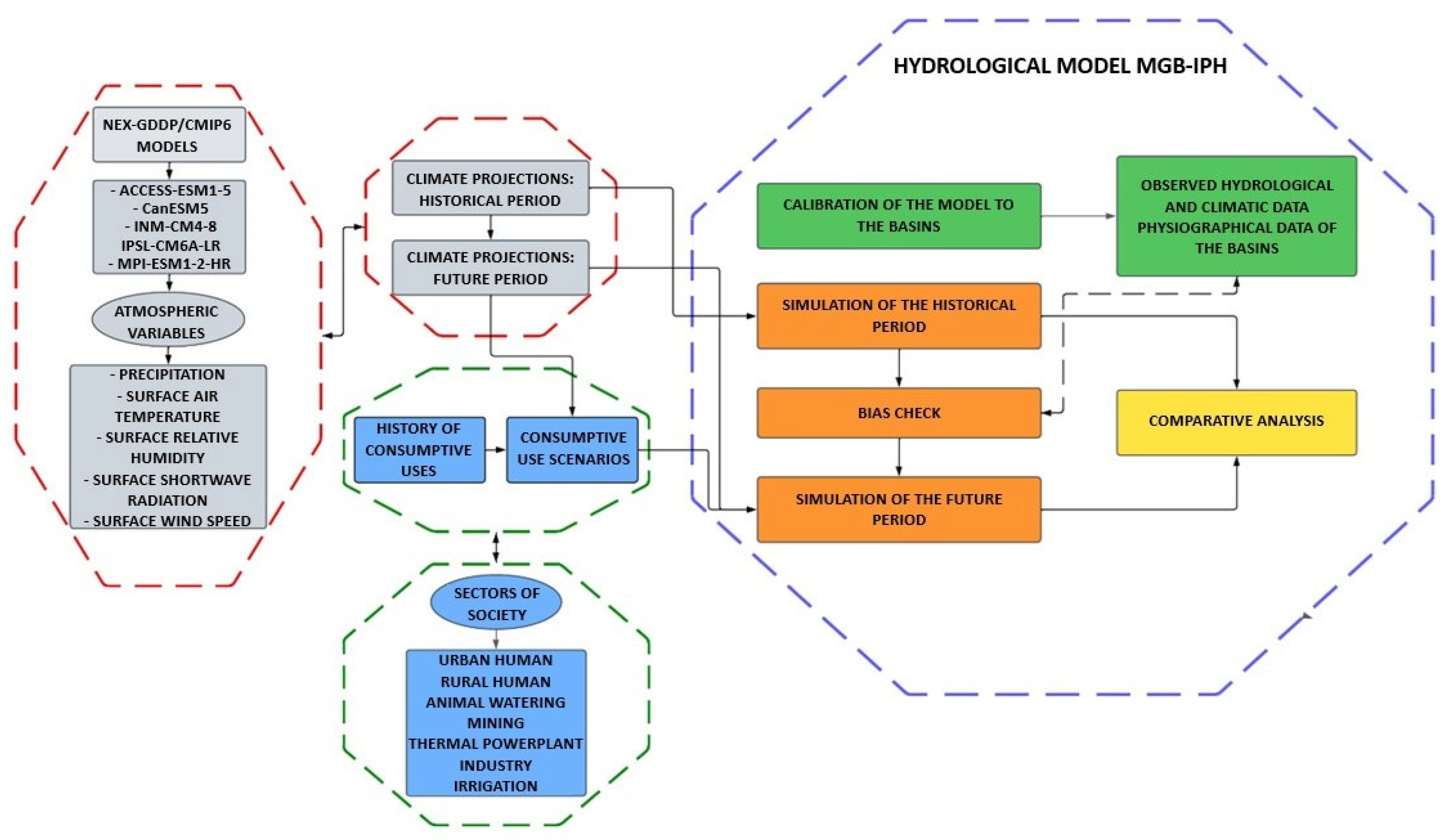

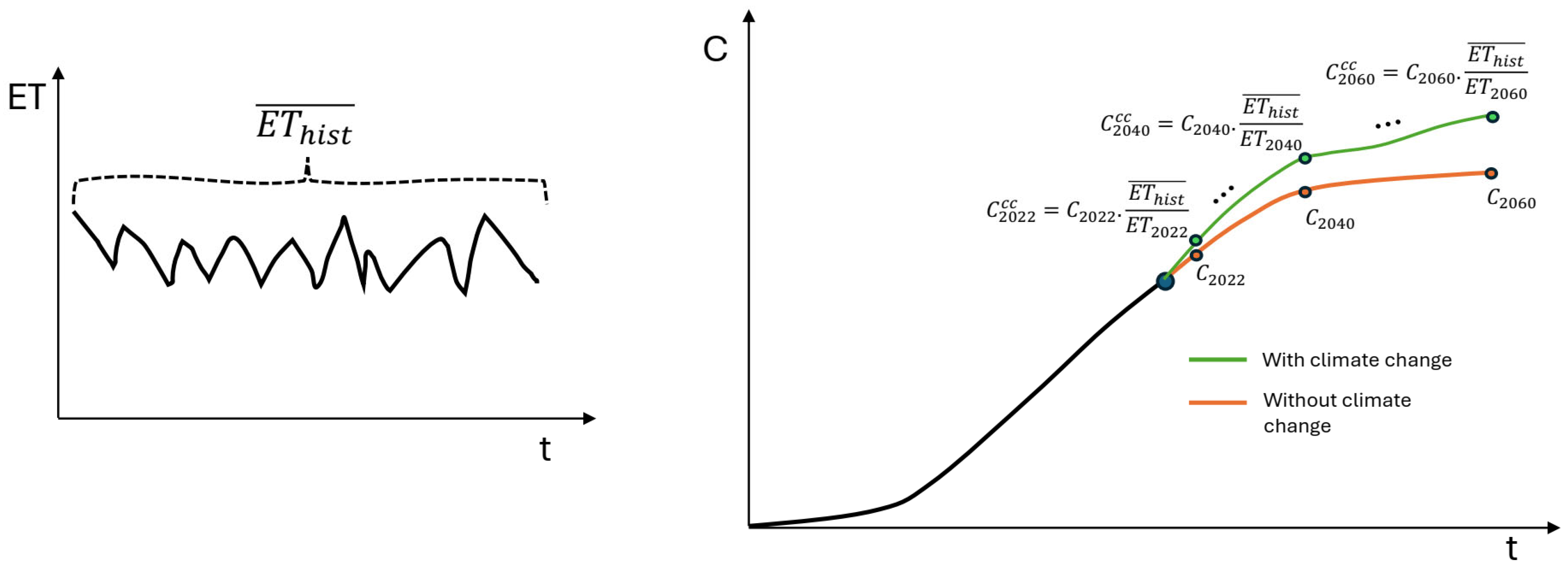
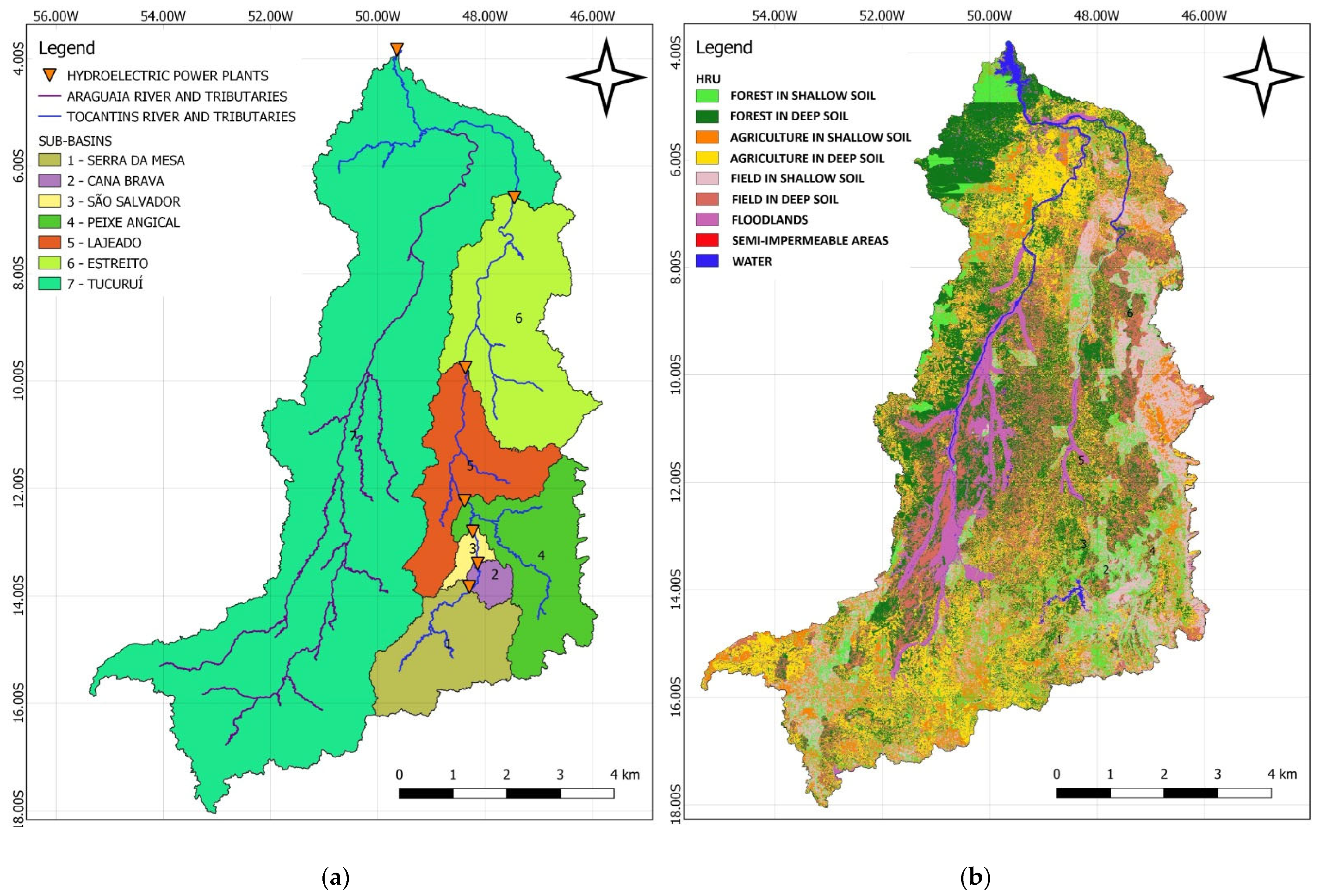
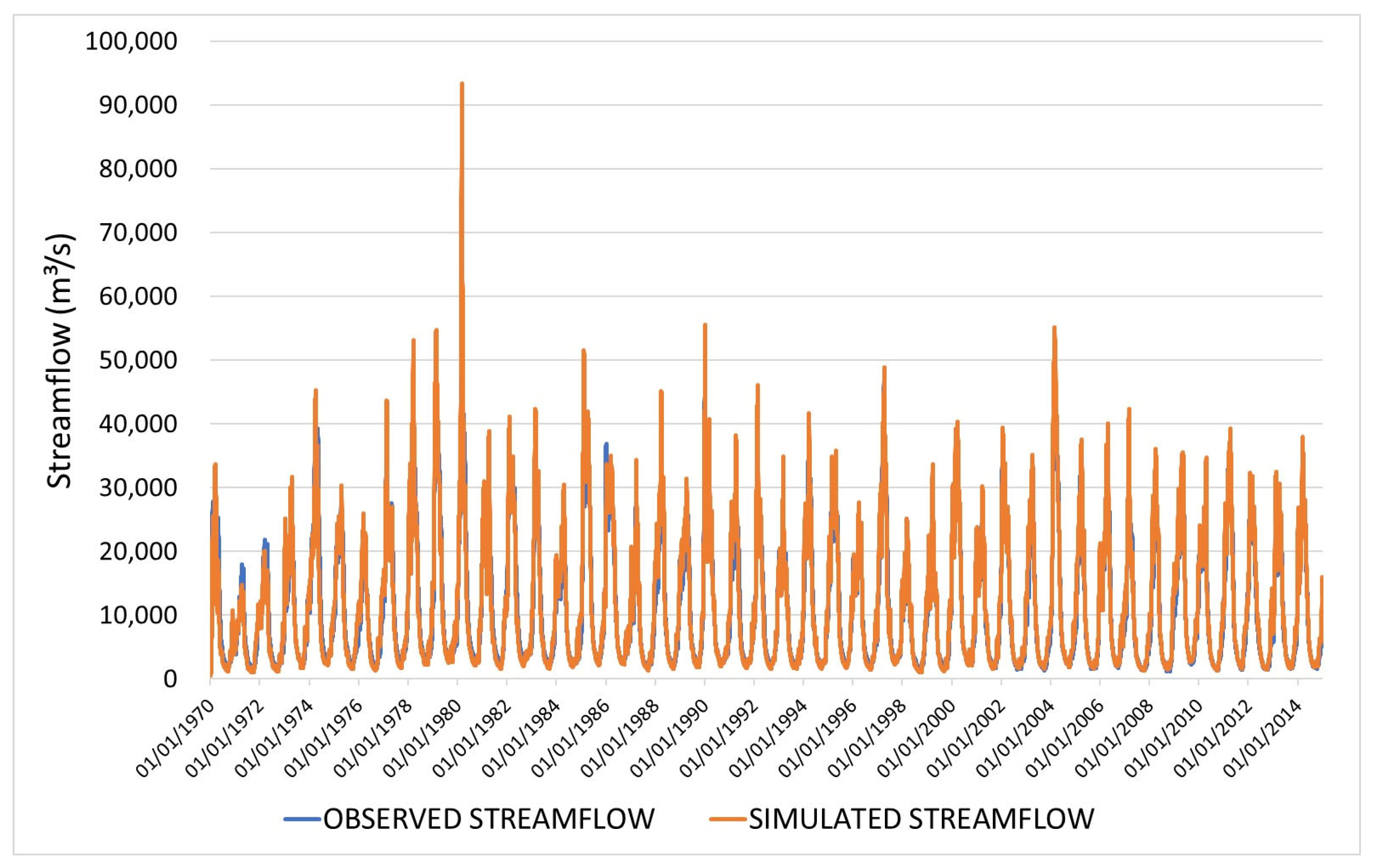


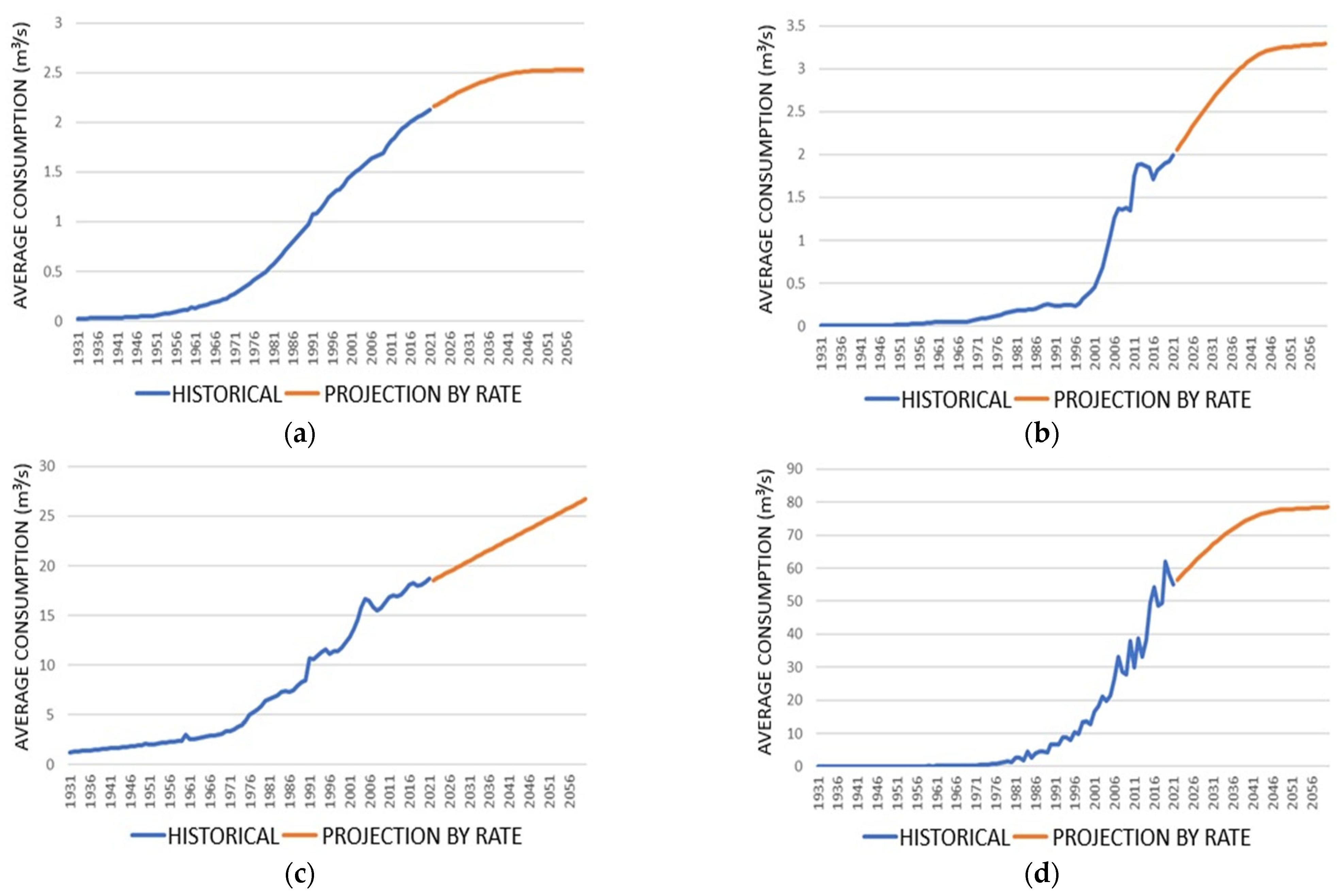
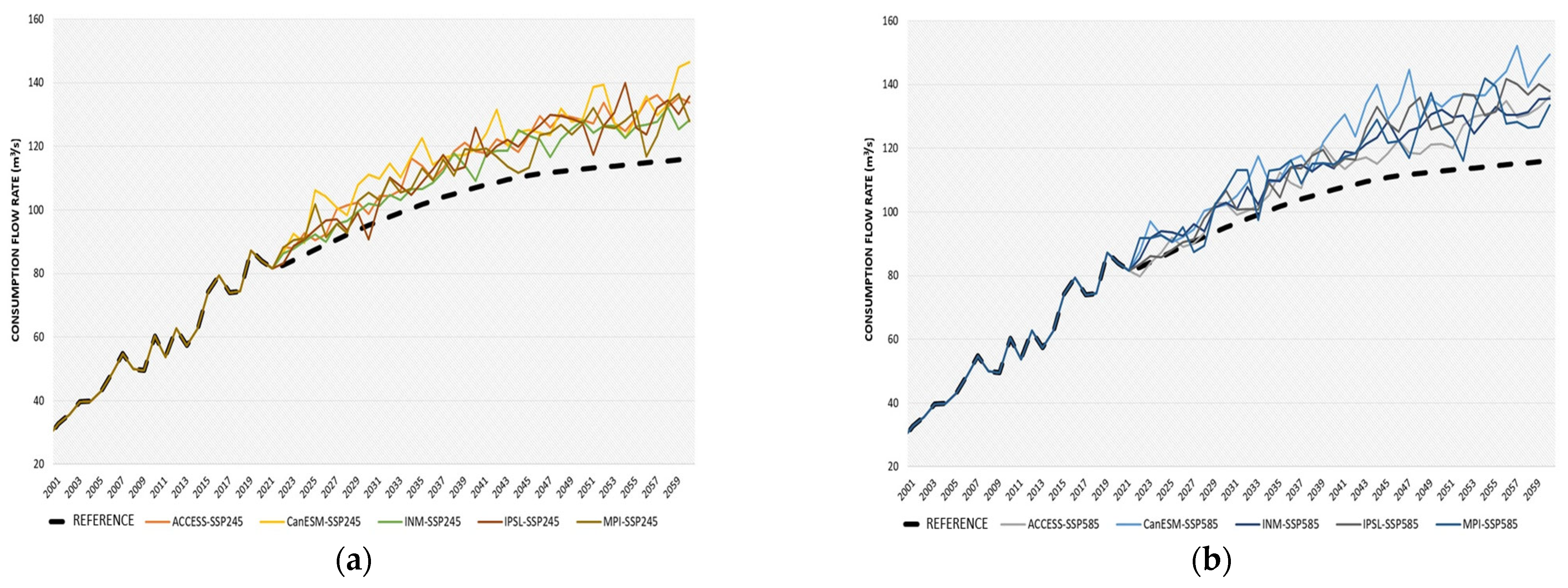



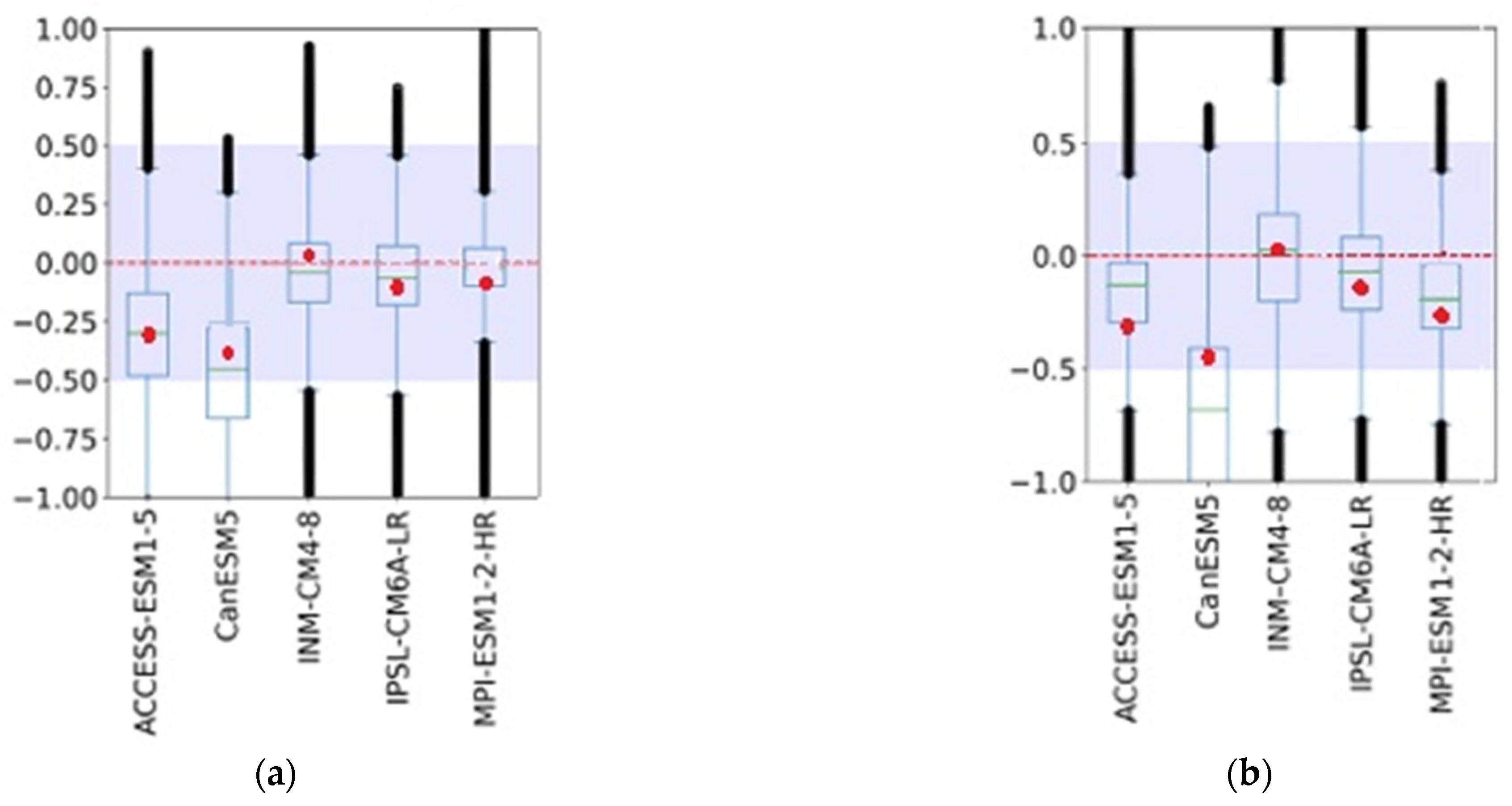
| Classification | NS or NSlog | ΔV |
|---|---|---|
| Very good | >0.75 and ≤1.00 | >±10% |
| Good | >0.65 and ≤0.75 | ±10% ≤ ΔV < ±15% |
| Satisfactory | >0.50 and ≤0.65 | ±15% ≤ ΔV < ±25% |
| Not satisfactory | ≤0.50 | ΔV ≥ ±25% |
| Model | Developed | Country |
|---|---|---|
| ACCESS-ESM1-5 | Australian Community Climate and Earth System Simulator | Australia |
| CanESM5 | Canadian Centre for Climate Modelling and Analysis | Canada |
| INM-CM4-8 | Institute of Numerical Mathematics of the Russian Academy of Sciences | Russia |
| IPSL-CM6A-LR | Institute Pierre-Simon Laplace | France |
| MPI-ESM1-2-HR | Max Planck Institute for Meteorology Earth System Model | Germany |
| Sub-Basin | Hydroelectric Power Plant | NS | Nslog | ΔV |
|---|---|---|---|---|
| 1 | UHE Serra da Mesa | 0.863 | 0.880 | 4.852 |
| 2 | UHE Cana Brava | 0.866 | 0.868 | 5.577 |
| 3 | UHE São Salvador | 0.872 | 0.867 | 5.576 |
| 4 | UHE Peixe Angical | 0.871 | 0.884 | 5.985 |
| 5 | UHE Lajeado | 0.915 | 0.906 | 8.073 |
| 6 | UHE Estreito | 0.907 | 0.902 | 7.493 |
| 7 | UHE Tucuruí | 0.911 | 0.943 | 6.821 |
Disclaimer/Publisher’s Note: The statements, opinions and data contained in all publications are solely those of the individual author(s) and contributor(s) and not of MDPI and/or the editor(s). MDPI and/or the editor(s) disclaim responsibility for any injury to people or property resulting from any ideas, methods, instructions or products referred to in the content. |
© 2025 by the authors. Licensee MDPI, Basel, Switzerland. This article is an open access article distributed under the terms and conditions of the Creative Commons Attribution (CC BY) license (https://creativecommons.org/licenses/by/4.0/).
Share and Cite
Passos, F.O.; da Silva, B.C.; de Lima, J.W.M.; Barbosa, M.d.A.; Machado, P.H.G.; Martins, R.M. The Impact of Climate Change and Water Consumption on the Inflows of Hydroelectric Power Plants in the Central Region of Brazil. Climate 2025, 13, 140. https://doi.org/10.3390/cli13070140
Passos FO, da Silva BC, de Lima JWM, Barbosa MdA, Machado PHG, Martins RM. The Impact of Climate Change and Water Consumption on the Inflows of Hydroelectric Power Plants in the Central Region of Brazil. Climate. 2025; 13(7):140. https://doi.org/10.3390/cli13070140
Chicago/Turabian StylePassos, Filipe Otávio, Benedito Cláudio da Silva, José Wanderley Marangon de Lima, Marina de Almeida Barbosa, Pedro Henrique Gomes Machado, and Rafael Machado Martins. 2025. "The Impact of Climate Change and Water Consumption on the Inflows of Hydroelectric Power Plants in the Central Region of Brazil" Climate 13, no. 7: 140. https://doi.org/10.3390/cli13070140
APA StylePassos, F. O., da Silva, B. C., de Lima, J. W. M., Barbosa, M. d. A., Machado, P. H. G., & Martins, R. M. (2025). The Impact of Climate Change and Water Consumption on the Inflows of Hydroelectric Power Plants in the Central Region of Brazil. Climate, 13(7), 140. https://doi.org/10.3390/cli13070140








